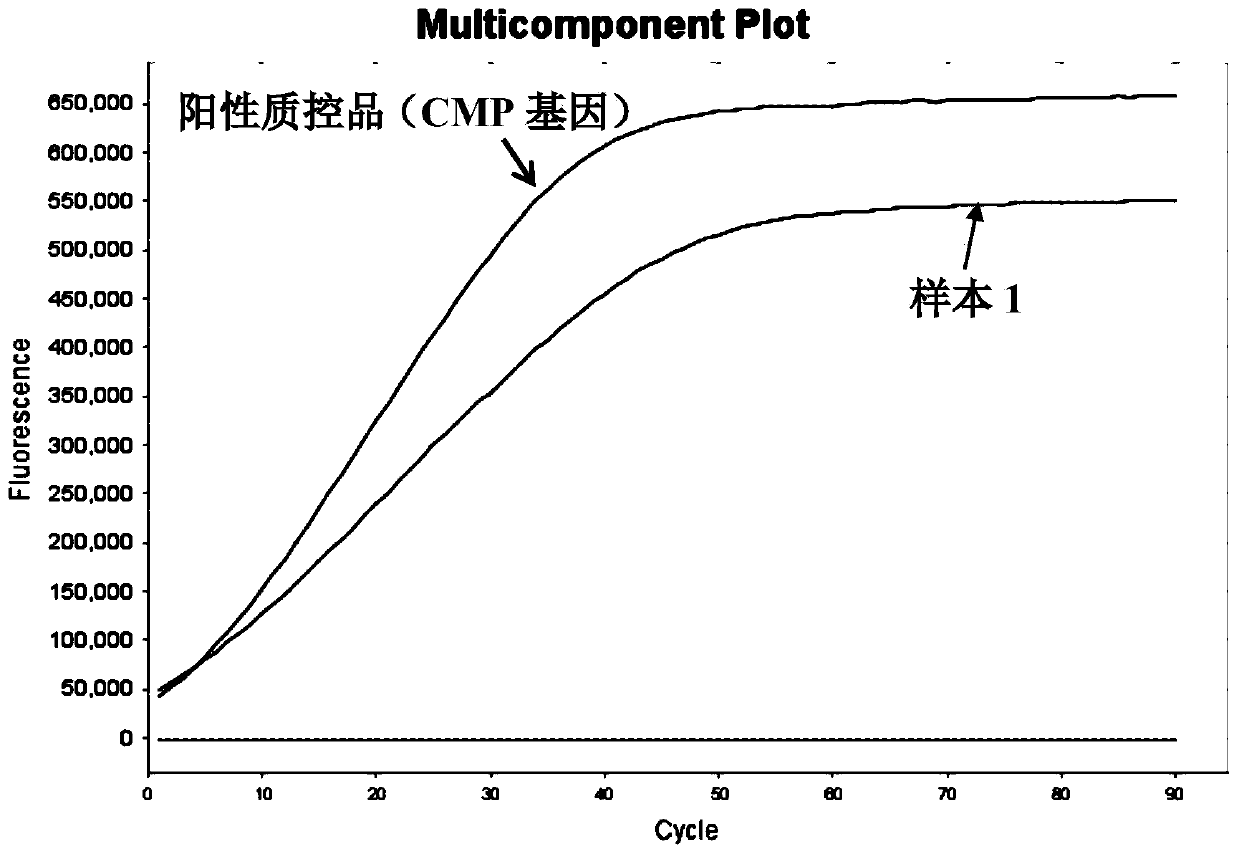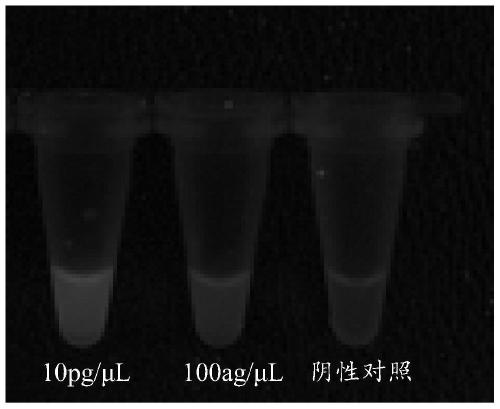Primer set, kit and method for performing isothermal detection on CRISPR-Cas12a protease of prawn iridescent viruses
A technology for detecting kits and iridescent viruses, which is applied in the field of molecular biology, can solve problems that have not been reported, and achieve the effects of avoiding false positives, increasing copy number, and easy operation
- Summary
- Abstract
- Description
- Claims
- Application Information
AI Technical Summary
Problems solved by technology
Method used
Image
Examples
Embodiment 1
[0044] 1. Experimental materials
[0045] Sample 1: Shrimp seedlings obtained from the Hangzhou Shrimp Larvae Base (provided by Zhejiang Aquatic Technology Extension Station).
[0046] Positive quality control product: Pet28a-CMP plasmid, the nucleotide sequence is shown in SEQ ID NO.5.
[0047] 2. Extraction of Shrimp Iridovirus DNA
[0048] (1) Weigh 30 mg of the experimental sample (take the whole shrimp seedlings), add 500 μL of physiological saline, mix upside down, remove the liquid, and repeat this step once;
[0049] (2) Put the washed shrimp seedlings in a grinding tube, add 1 grinding bead (8 mm in diameter), add 100 μL of lysate, put it into a homogenizer, and homogenize at 6 m / s for 20 s;
[0050] (3) Add 100 μL of lysate and 20 μL of proteinase K, and incubate at 56°C for 1 hour;
[0051] (4) Add 200 μL of binding solution and incubate at 70°C for 10 min;
[0052] (5) Add 200 μL of absolute ethanol, mix it upside down, add it to the adsorption column, and cent...
Embodiment 2
[0102] Embodiment 2 primer specificity experiment
[0103] 1. Detection method
[0104] In order to detect the primer specificity of the kit provided in Example 1, the CRISPR-Cas12a protease isothermal amplification detection method provided in the third part of Example 1 was used to detect viruses WSSV (prawn white spot syndrome virus), IHHNV (infectious Subcutaneous and hematopoietic necrosis virus), EHP (Shrimp Enterococcus hepatica), SHIV (Shrimp Iridescent Virus) were detected, and the detection status of the reagents on SHIV virus and other common viruses in prawns was analyzed.
[0105] 2. Test results
[0106] The test results show that only the virus SHIV sample has an "S" type amplification curve, and the negative control (ultrapure water) and virus WSSV, IHHNV, EHP samples do not appear to be amplified (such as image 3 shown).
[0107] The above experimental results show that the CRISPR-Cas12a protease isothermal amplification detection kit provided in Part 3 of...
Embodiment 3
[0108] Embodiment 3 Sensitivity experiment
[0109] 1. Detection method
[0110]Extract the positive plasmid (T vector containing the target sequence fragment), quantify the positive plasmid by NanoDrop One, and dilute it to 10pg / μL, 1pg / μL, 100ag / μL, 10ag / μL, 1ag / μL, 0.1ag / μL. The above-mentioned CRISPR-Cas12a protease detection method was used to amplify and detect the diluted positive plasmids at various concentrations.
[0111] 2. Test results
[0112] Test results such as Figure 4 As shown, the curves from left to right are the amplification results of positive standards of 10pg / μL, 1pg / μL, 100ag / μL, 10ag / μL, 1ag / μL, and 0.1ag / μL, from which it can be seen that the present invention The detection sensitivity of the CRISPR-Cas12a kit can reach 0.1ag / μL, and the accuracy is better than that of ordinary PCR detection methods, indicating that the CRISPR-Cas12a protease detection kit and detection method of the present invention have high sensitivity for the diagnosis of...
PUM
 Login to View More
Login to View More Abstract
Description
Claims
Application Information
 Login to View More
Login to View More - R&D
- Intellectual Property
- Life Sciences
- Materials
- Tech Scout
- Unparalleled Data Quality
- Higher Quality Content
- 60% Fewer Hallucinations
Browse by: Latest US Patents, China's latest patents, Technical Efficacy Thesaurus, Application Domain, Technology Topic, Popular Technical Reports.
© 2025 PatSnap. All rights reserved.Legal|Privacy policy|Modern Slavery Act Transparency Statement|Sitemap|About US| Contact US: help@patsnap.com



